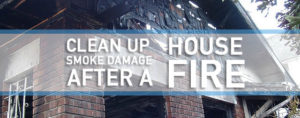Some would say there’s nothing worse that could possibly happen in a residential property than a fire. Not only is your home likely to be ruined along with the vast majority of your belongings, the safety of you and your family is at grave risk.
 Once the fire is extinguished, most home owners are relieved that the ordeal has come to an end. However, the unfortunate circumstances of a fire often result in extensive smoke damage.
Once the fire is extinguished, most home owners are relieved that the ordeal has come to an end. However, the unfortunate circumstances of a fire often result in extensive smoke damage.
When you first re-enter your home after a blaze, you are likely to have to deal with smoke, soot and the water and chemicals used by firefighters to extinguish the fire itself. The extent of the damage will likely be seen all around you, with walls and ceilings blackened by the smoke and soot.
There are two important things to know about the aftermath of a fire if you are preparing for this demanding DIY job – odour from smoke and soot. Use the helpful tips we’ve provided below to get your home back in shape as soon as possible.
What you will need to get started…
- The cleaning items you’ll need to start cleaning up after a house fire are:
- Rubber gloves for cleaning and protection from chemicals used by firefighters
- A large sponge with the capacity to soak up plenty of water in one go
- A heavy-duty cleaning solution containing Trisodium phosphate
- Old rags or clothes that you can use for cleaning
- Two large buckets of warm water
- Goggles to protect your face and a mask if necessary
Soot and the result of smoke damage
Soot is made up of numerous carbon-based impurities that are produced after belongings are burned or charred. It is usually caused when materials do not burn entirely. The presence of plastic in almost every modern home means that the texture of soot is usually oily and unpleasant. When plastic burns these oily molecules are released into the air.
The importance of goggles during this DIY job is imperative because soot is a potential health hazard. The respiratory system can be affected by large quantities of soot in a small space, with small quantities capable of reaching the bloodstream through alveoli in the lungs.
It is very likely that many of your belongings and possessions will have been damaged or destroyed in the fire which means replacements will almost certainly be necessary. However, you will only know what needs replacing when the clean-up is complete. Instead of focusing on what you’ve lost, try to remain positive and get on with the cleaning job as this will bring you closer to identifying the items you have lost.
Smoke odour
A fire-damaged house is usually filled with the unpleasant odour that seems to have little to no origin. Smoke damage is quite hard to identify but you can safely say that, if any unpleasant odour is present, smoke damage is the underlying cause. It is a complicated issue to deal with because the problems often stem from molecules in the air.
Although it is advisable to contact experts who specialise in getting rid of the odour, if you plan to tackle the job yourself you will need something that smells strong enough to counter the odour and also acts as a freshener.
The strength of the solution you come up with must be able to overcome the molecules present in the property that are causing the unpleasant odour. Here’s what you need to make a highly effective post-fire air freshener.
- White vinegar
- Baking soda
- Activated charcoal
- Odour-reducing products
- Ozone generators
- Odour-reducing fogs
Article provided by Mike James, working together with London-based cleaning specialist Cleaning Industrial Solutions.




